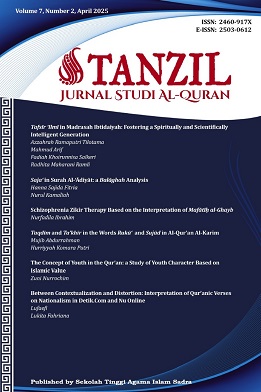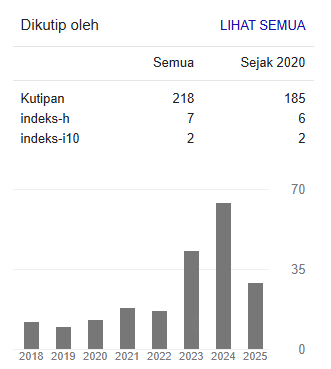SAJA‘ IN SURAH AL-‘ĀDIYĀT
A BALĀGHAH ANALYSIS
DOI:
https://doi.org/10.20871/tjsq.v7i2.395Keywords:
Al-Qur’an, Analisis Balāghah, Saja‘, Surah Al-‘ĀdiyātAbstract
Surah Al-‘Ādiyāt, which consists of 11 verses, contains the use of structured, rhythmic, and poetic language styles (saja‘). This study aims to reveal how the rhythm and structure of the language in this surah not only beautify the text but also arouse the emotions and awareness of the readers towards the messages contained in the Qur’an. The problem raised in this study is how the use of saja‘ language style contributes to beautifying and deepening the meaning and message that the Qur’an wants to convey. This research uses a qualitative approach with a content analysis method, with a focus on analyzing the metaphor of the elements used, as well as the uslub (language style) that supports the meaning of the metaphor. The results of the analysis show that there are several types of saja‘ in Surah Al-‘Ādiyāt, namely saja‘ muṭarraf as much as 1 data, saja‘ mutawāzī 3 data, and saja‘ muraṣṣa‘ 1 data. These findings provide a very clear picture of the important role of language styles in enriching meaning and also in increasing aesthetic power in the Qur’an. By using a structured and rhythmic language style, Surah Al-‘Ādiyāt not only succeeds in beautifying the text but also serves as a means to arouse the reader's feelings and understanding of the realities of life, the forces of nature, and the warnings contained in the divine message. This shows how the beauty of the language of the Qur’an helps deepen the spiritual and moral message for humanity.
References
Abdurrahman, Abdurrahman, Mirsa Triandani, and Harun Al Rasyid. “IQTIBAS: Mendeteksi Prosa dan Syair dalam Al-Qur’an dan Hadis.” Perspektif: Jurnal Pendidikan dan Ilmu Bahasa 3, no. 1 (22 January 2025): 185–92. https://doi.org/10.59059/perspektif.v3i1.2106.
Anggraini, Dwi Puspa, Syihabuddin Syihabuddin, and Asep Sopian. “The Ithnab Style in Quranic Stylistics: A Study of Structure.” Ad-Dhuha: Jurnal Pendidikan Bahasa Arab dan Budaya Islam 4, no. 2 (31 October 2023): 53–61. https://doi.org/10.22437/jurnalpendidikanbahasaarabdanbudayaislam.v4i2.28003.
Aritonang, Pebrina Yanti, Nurul Aulia Ersa Putri, Said Fahrezi, and Harun al Rasyid. “Tasybīh Al-Tamṡīl dalam Al-Qur’an: Analisis Balagāh Pada Surah Al-Kahfi Ayat 45.” Al Furqan: Jurnal Ilmu Al Quran dan Tafsir 7, no. 1 (19 June 2024): 142–58. https://doi.org/10.58518/alfurqon.v7i1.2672.
Arraid, M. Salwa. “Gaya Bahasa Jinās dan Saja’ dalam Surah Al-Qiyāmah.” JILSA (Jurnal Ilmu Linguistik dan Sastra Arab) 7, no. 1 (28 April 2023): 57–67. https://doi.org/10.15642/jilsa.2023.7.1.57-67.
Awadin, Adi Pratama, Ahmad Zuhdi, Fitroh Ni’matul Kafiyah, Edi Sutardi, and Edi Komarudin. “Epistemologi Ilmu Balaghah dalam Al-Qur’an.” Lahjah Arabiyah: Jurnal Bahasa Arab dan Pendidikan Bahasa Arab 6, no. 1 (4 February 2025): 87–102. https://doi.org/10.35316/lahjah.v6i1.87-102.
Bestari, Muhammad. “Al-Qur’an Sebagai Wahyu Allah, Muatan Beserta Fungsinya.” Dirasat 15, no. 2 (2020): 118–37.
Chaer, Hasanuddin, Abdul Rasyad, and Ahmad Sirulhaq. “Retorika Alquran Sebagai Pembelajaran Bahasa.” Lingua Franca: Jurnal Bahasa, Sastra, dan Pengajarannya 8, no. 1 (29 February 2024): 80–94.
Fajri, Muhammad. “Dynamics of The Study of The Quran in Indonesia: Language and Paradigm.” Islam Transformatif: Journal of Islamic Studies 5, no. 1 (23 August 2021): 46–58. https://doi.org/10.30983/it.v5i1.4130.
Habibi, Ahyat, Inanda Tsabithah Salsabila, and Adi Aprianto. “Keindahan Ilmu Badi’ dari Hadis-Hadis Pilihan dalam Arba’in Nawawi: (Studi Analisis Bahasa).” Al-Majaalis: Jurnal Dirasat Islamiyah 12, no. 1 (2 November 2024): 94–120. https://doi.org/10.37397/al-majaalis.v12i1.698.
Hafidz, Muhammad. “Memahami Balaghah dengan Mudah.” TA’LIMUNA: Jurnal Pendidikan Islam 7, no. 2 (8 October 2018): 129–45. https://doi.org/10.32478/talimuna.v7i2.187.
Idris, Mardjoko. “Gaya Bahasa Jinâs dalam Al-Qurân: (Kajian Struktur dan Makna).” Al-Lubab: Jurnal Penelitian Pendidikan dan Keagamaan Islam 5, no. 2 (13 November 2019): 171–91. https://doi.org/10.19120/al-lubab.v5i2.3912.
Jannah, Raudhatul, Ariza Amalia, Nabila Nashfati, and Harun Al-Rasyid. “Saj’ Murashsha’ dalam Surah Al-Waqi’ah: (Studi Analisis Balaghah).” Reflection: Islamic Education Journal 2, no. 1 (2025): 236–43. https://doi.org/10.61132/reflection.v2i1.458.
Kamil, Sukron, Rizqi Handayani, and Abdurrosyid Abdurrosyid. “Semiotics as a Standard for Interpretation of Islamic Texts: Studies Based on Science of Balagah and Exegesis.” Jurnal Lektur Keagamaan 21, no. 2 (11 December 2023): 493–526. https://doi.org/10.31291/jlka.v21i2.1129.
Lorenza, Lola Irnis, Rafly Syahputra, and Harun Al-Rasyid. “Ta’kid Al-Madh Bima Yusybih Al-Dzamm dan Ta’kid Al-Dzamm Bima Yusybih Al-Madh: (Mempertegas Pujian dengan Nuansa Hinaan dan Mempertegas Hinaan dengan Nuansa Pujian).” Jurnal Bintang Pendidikan Indonesia 3, no. 1 (2 January 2025): 210–20. https://doi.org/10.55606/jubpi.v3i1.3587.
Ma’ruf, Muchamad Ali, Mirza Ghulam Maula, and Nursahidah Awalia. “Kajian Saja’ dalam Nadzom Tajwid Kitab Syifa’ul Janan Karya Kyai Haji Ahmad Muthohhar.” International Conference of Students on Arabic Language 4, no. 0 (18 July 2020): 595–605.
Mekarisce, Arnild Augina. “Teknik Pemeriksaan Keabsahan Data Pada Penelitian Kualitatif di Bidang Kesehatan Masyarakat.” Jurnal Ilmiah Kesehatan Masyarakat: Media Komunikasi Komunitas Kesehatan Masyarakat 12, no. 3 (10 September 2020): 145–51. https://doi.org/10.52022/jikm.v12i3.102.
Muhsin, Wahab, and T. Fuad Wahab. Pokok-Pokok Ilmu Balaghah. Bandung: Angkasa, 1982.
Multazim, Hamzah, and Hasan Busri. “At-Thibaq dalam Al-Quran Surat Al-Baqarah-At-Taubah (Tinjauan Balaghah).” Lisanul Arab: Journal of Arabic Learning and Teaching 7, no. 1 (25 September 2018): 27–36. https://doi.org/10.15294/la.v7i1.26066.
Mursyid, Ali. “Sisi-Sisi Keindahan Bahasa Al-Qur’an.” MISYKAT: Jurnal Ilmu-Ilmu Al-Quran Hadits Syari’ah dan Tarbiyah 4, no. 2 (30 December 2019): 23–60.
Nasution, Muhammad Fadlan Rawi, Mario Bagus Sanjaya, Nayla Khalisa, and Harun Al-Rasyid. “Analisis Kajian As-Saj’u dalam Surah Al Ghasiyah.” Populer: Jurnal Penelitian Mahasiswa 4, no. 1 (17 January 2025): 46–53. https://doi.org/10.58192/populer.v4i1.2952.
Nisai, Luluun, and Tulus Musthofa. “Muqobalah dalam Surah Al-Rahman dan Implikasinya Terhadap Ma’na.” Proceeding of Conference on Strengthening Islamic Studies in The Digital Era 1, no. 1 (16 September 2021): 131-153.
Nurafika, Alfi, Khoirun Niat, and Nur Aini. “Majaz Isti’arah dalam Surah Yasin: Studi Pemikiran Ibn ‘Asyur dalam Kitab Al-Tahrir Wa Al-Tanwir.” Jalsah: The Journal of Al-Quran and As-Sunnah Studies 2, no. 2 (31 October 2022): 51–74. https://doi.org/10.37252/jqs.v2i2.357.
Nurdin, Aldi, Edi Komarudin, and Wildan Taufik. “Analisis Thibaq dalam Surah Al-Ahzab.” Jurnal Penelitian Ilmu Ushuluddin 4, no. 3 (3 September 2024): 149–61. https://doi.org/10.15575/jpiu.38661.
Pasaribu, Annisa Khairida, Berliana Sari Harahap, and Harun Al-Rasyid. “Analisis Ta’kid Al-Madh Bima Yusybih Al-Dzamm dan Ta’kid Al-Dzamm Bima Yusybih Al-Madh dalam Surah Al Qolam Ayat 4 dan Surat Al Ma’un Ayat 4-5.” Mutiara: Jurnal Penelitian dan Karya Ilmiah 3, no. 1 (13 January 2025): 270–75. https://doi.org/10.59059/mutiara.v3i1.2074.
Rahim, Abdur, Aulia Unnisa, Salwa Haifa, and Harun Al-Rasyid. “Analisis Surah Al-Baqarah Ayat 185 dan Surah Al-A’raf Ayat 26 dalam Kajian Al-Istikhdam dan Al-Istithrad.” Perspektif: Jurnal Pendidikan dan Ilmu Bahasa 3, no. 1 (6 January 2025): 27–33. https://doi.org/10.59059/perspektif.v3i1.2043.
Rifai, Juhdi. “Pendekatan Ilmu Balaghah dalam Shafwah Al-Tafâsîr Karya ‘Ali Al-Shabuny.” Jurnal Ulunnuha 8, no. 2 (2019): 245–66. https://doi.org/10.15548/ju.v8i2.1256.
Riki, Riki, Nasrul Mu’minun, and Musdalipa. “Saja’ dalam Al-Qur’an Surah Al- Muthaffifin (Studi Analisis Balaghah).” Al-MUALLAQAT 3, no. 2 (30 June 2024): 12–18.
Sagala, Rumadani. Balaghah. Lampung: Fakultas Tarbiyah dan Keguruan Institut Agama Islam Negeri Raden Intan, 2016.
Sunardi, Ahmad Dahlan. “Pendidikan Islam Perspektif M. Natsir.” Dirasat Journal: Jurnal Studi Islam dan Peradaban 15, no. 2 (2020). https://ejournal.staiindojkt.ac.id/index.php/dirasat/issue/view/6.
Suryani, Khotimah. “Keunggulan Bahasa Al-Qur’an di Bidang Sastra (Al-Balaghah) dalam Pandangan Ibn Asyur.” Dar El-Ilmi: Jurnal Studi Keagamaan, Pendidikan dan Humaniora 6, no. 2 (22 October 2019): 220–45. https://doi.org/10.52166/dar.
Syafirin, Muhammad. “The Myth of “Abū Lahab” in Q.S. Al-Masad [111]: 1: Analysis of Roland Barthes’ Semiotic Theory.” Tanzil: Jurnal Studi Al-Quran 7, no. 1 (8 October 2024): 39–58. https://doi.org/10.20871/tjsq.v7i1.352.
Tarlam, Alam. “Studi Analisis Metodologi Tafsir Mafatih Al-Ghayb Karya Fakruddin Al-Razi.” AL-KAINAH: Journal of Islamic Studies 2, no. 1 (21 June 2023): 46–68. https://doi.org/10.69698/jis.v2i1.112.
Wahyuni, Cut Sri, and Tatik Maryatut Tasnimah. “Komparasi Ilmu Badi’ Ibnu Mu’taz dan Ilmu Badi’ Kontemporer.” An-Nahdah Al-’Arabiyah 2, no. 2 (8 August 2022): 132–44. https://doi.org/10.22373/nahdah.v2i2.1788.
Yahya, Yuangga Kurnia. “Gaya Bahasa Tauriyah dalam Al-Qur’an.” Arabiyatuna: Jurnal Bahasa Arab 2, no. 1 June (30 June 2018): 35–48. https://doi.org/10.29240/jba.v2i1.364.
Downloads
Published
How to Cite
Issue
Section
License
Copyright (c) 2025 Hanna Sajida Fitria, Nurul Kamaliah

This work is licensed under a Creative Commons Attribution 4.0 International License.






















